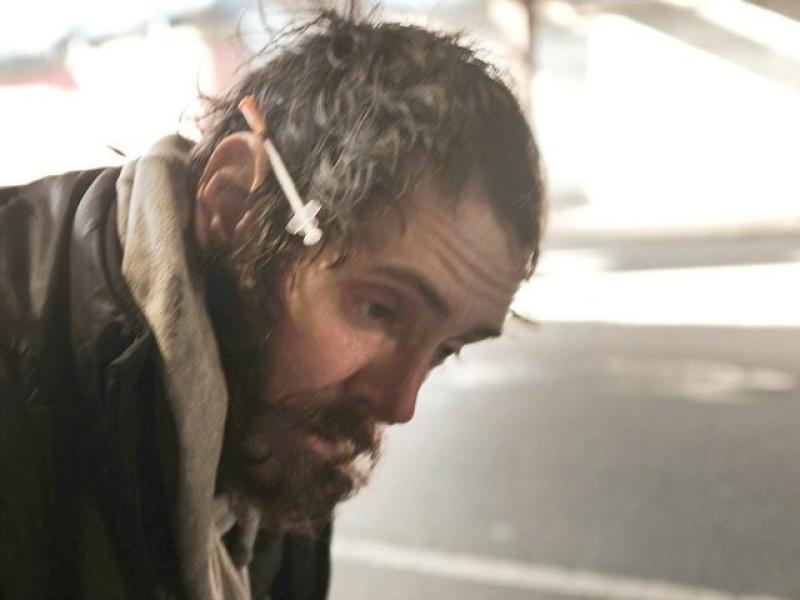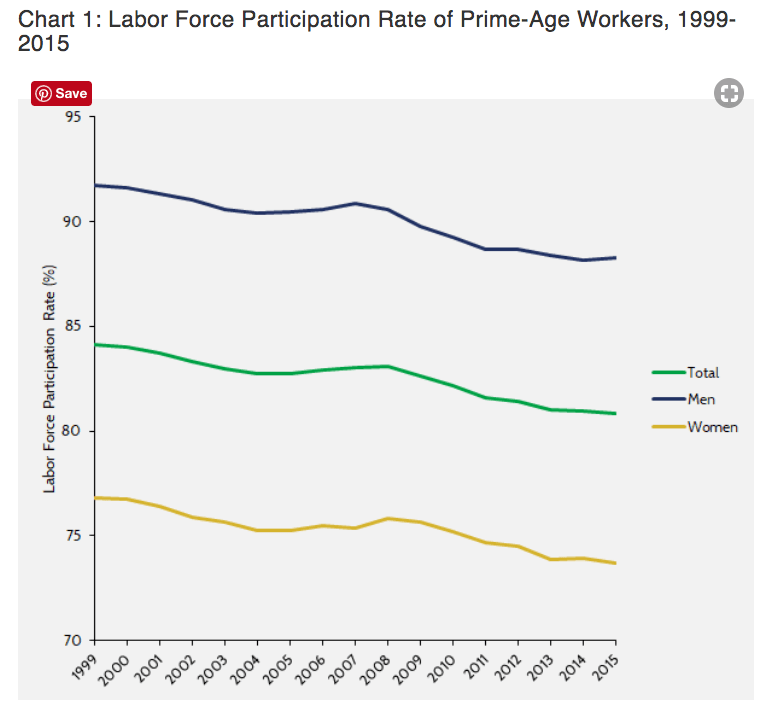Report: Opioid Drugs Dragged 1 Million Americans Out of the Workforce

28 Mar 2018
Almost 1 million prime-age Americans were dragged out of the 2015 labor force by Chinese-supplied fentanyl, Mexican heroin and U.S-made prescription opioid drugs, says a report by the American Action Forum, a business-first advocacy group.
The economic impact of this opioid drug disaster adds up to $91 billion in lost productivity during 2015, alongside 42,000 deaths in 2016, says the group, which also advocates for easier migration of foreign workers .
The report shows that 4 million prime American men and women — aged 25 to 54 — left the workforce between 1999 and 2015. The huge departure has been blamed on trade, on technology and the decline in blue-collar wages , and it accelerated in 2008 when the economy collapsed because of the government’s risky and bipartisan push to expand home-ownership.

Overall, roughly one-quarter of the 4 million Americans who quit the workforce were also entangled in drugs, says the AAF report, which does not offer any recommendations for fixing the drug-and-workforce problem.
advertisement
However, President Donald Trump has repeatedly argued that a border wall can reduce the flow of drugs, and that immigration reform will raise wages, drag Americans back to work, and away from drugs.

In fact, an economics paper cited in the AAF report noted that:
Although labor market shifts that have lowered demand and wages for less skilled workers have not been a focus of this study, policies that raise after-tax wages for low-wage workers, such as an increase in the minimum wage or expansion of the Earned Income Tax Credit, would also likely help raise labor force participation.
Post-2015 data shows Trump’s immigration-and-drugs plan seems to be working. For example, since 2014, the number of Americans who say health problems keep them from working has fallen by 1.5 million as CEOs are forced to hire marginalized Americans workers because populist voters have blocked multiple amnesty bills since 2013.
I'm in the @UpshotNYT today bearing good news: the number of prime-age Americans out of the labor force due to disability is falling at unprecedented rates. /1 https://t.co/Me7S8ou7Oe
— Ernie Tedeschi (@ernietedeschi) March 15, 2018
Breitbart News reported March 25:
Disabled Americans are getting more jobs as CEOs try to recruit new workers without raising wages in President Donald Trump’s tight labor market …
The number of disabled unemployed has dropped by 1.5 million, down to 6.7 million in 2018. The number had risen from 5 million in 1998 up to 7.2 million in 2014 …
… the 2013 “Gang of Eight” amnesty-and-immigration bill … would have dropped wages for at least a decade by adding up to 30 million legal workers in one decade, according to the June 2013 report by the Congressional Budget Office:
Because the bill would increase the rate of growth of the labor force, average wages would be held down in the first decade after enactment by a reduction in the ratio of capital to labor.
The AAF report carefully explains the economic and civic impact of the drug disaster:
America’s growing dependency on painkillers has evolved into a full-blown crisis. In particular, millions of people have developed opioid-related substance abuse disorders, leading to a rapid rise in opioid overdoses. In 2016 alone, over 42,000 people died after overdosing on opioids, a 28 percent increase from 2015. [1] Moreover, in 2016, for every fatal opioid overdose, there were over 30 nonfatal overdoses. [2]
While the opioid crisis poses clear health problems, it is likely also negatively affecting the U.S. economy. The recent decline in the labor force participation rate of prime-age workers (ages 25 to 54) is a major factor restricting long-run economic growth, and research suggests that opioid dependency is a principal reason these individuals are leaving the workforce. This study estimates how many prime-age workers are absent from the labor force due to opioid dependency, the loss of hours at work, and the resulting decline in real (inflation-adjusted) economic output. It finds that from 1999 to 2015, opioids steadily drew workers out of the labor force. By 2015, 919,400 prime-age workers were out of the labor force due to opioids. Between 1999 and 2015, this decline in labor force participation cumulatively cost the U.S. economy 12.1 billion work hours and $702.1 billion in real output ($43.9 billion per year) …
To put these figures in perspective, consider that the average annual lost output of $43.9 billion equates to $140 per U.S. resident. The $91.6 billion lost in 2015 translates to $290 per resident. [27] Moreover, between 1999 and 2015, real GDP grew at an annual compounded rate of 2 percent. Had opioid dependency not drawn so many workers out of the labor force, real GDP would have grown at a 2.2 percent rate, a 0.2 percentage point (or 10 percent) increase in the economy’s growth rate.
The Labor Consequences of the Opioid Crisis in 60 Seconds — Ben Gitis
The report also cites other studies’ estimate of the accumulating economic cost of the drug crisis:
Researchers from the Centers for Disease Control (CDC) estimated the economic costs in 2013 of the opioid epidemic to be $78.5 billion. [15] Part of that cost estimate comes from a reduction in productivity due to opioids, an effect that does slow economic growth. But, a large portion of the cost estimate is cost burdens that opioid dependency places on individuals. In particular, the CDC’s $78.5 billion cost estimate includes individual spending on health care, substance abuse treatment, and legal expenses …
the Council of Economic Advisers (CEA) estimated the economic costs of the opioid epidemic to be $504 billion in 2015. [16] Yet, most of the CEA’s estimate is based on welfare costs associated with drug overdose fatalities. In particular, the CEA employs “value of statistical life” (VSL), a metric that federal agencies often use to quantify the benefits of a regulation that reduce fatalities. VSL represents the value of an individual’s life and is measured by estimating the amount that society is willing to pay for a single individual to continue living …
Most recently, Altarum estimated that since 2001 the opioid crisis has imposed over $1 trillion in economic costs. [17] While the study incorporates more economic costs than the CDC and CEA reports, it suffers from the same limitations by combining different kinds of costs. The Altarum estimate contains both the reduction in productivity among those still in the labor force and the lost lifetime production from opioid-related fatalities, both of which negatively impact economic output. Like the other studies, however, Altarum also combines those costs with costs that do not negatively impact GDP: spending on health care, criminal justice, and education.
Trump’s pro-American immigration-reform policies, however, are being fought-tooth-and-nail by business-first Republicans , progressive Democrats, business lobbies and their media allies . For example, the Senate blocked Trump’s immigration reforms in February, Congress’ 2018 omnibus in March only granted $641 million in 2018 to build 33 miles of border fences, and Democratic leaders are threatening to sue if Trump uses the military to build more fencing.
Four million Americans turn 18 each year and begin looking for good jobs in the free market.
But the federal government inflates the supply of new labor by annually accepting roughly 1.1 million new legal immigrants, by providing work-permits to roughly 3 million resident foreigners, and by doing little to block the employment of roughly 8 million illegal immigrants. Nationwide, the resident population of foreign guest workers includes roughly 1.5 million university-trained guest workers, such as L-1s and H-1Bs.
The Washington-imposed strategy of economic growth via cheap-labor mass-immigration shifts wealth from young people towards older people and to investors.
The strategy floods the labor market with foreign labor ; it spikes profits and Wall Street values by cutting salaries for manual and skilled labor offered by blue-collar and white-collar employees. It also drives up real estate prices , widens wealth-gaps , reduces high-tech investment , increases state and local tax burdens , hurts kids’ schools and college education , pushes Americans away from high-tech careers , and sidelines at least 5 million marginalized Americans and their families, including many who are now struggling with opioid addictions .

The economic drag is one thing, but the destruction of a life, whether it be young or old, is a tragedy. I saw enough drugs overseas when I was in the Air Force to last me a life time. I've known enough friends and associates whose child has succumbed to the addiction of drugs and most of them are dead today. I'm not sure if we Americans are concerned as much as we should be about this hideous demon opioid.
One night a young man goes to a party and everyone is drinking and smoking pot, but this night an old friend is there and some of them get away from the crowd and smoke some schmack or heroin. Yes, the heroin today is just like the heroin in Vietnam or many of the other Asian countries. You don't have to use a needle, you can smoke it in a cigarette what use to be called a rail, but is known as a primos today it seems. One night, sudden sickness, throwing up and a euphoria unlike he as ever experienced. It's OK, just one night and tomorrow is going to be another day, right? Well, it doesn't always work out that way. The euphoria is really enticing and more times than we would ever want, this young man does it a second time and then a third time. It doesn't take long for a person to become aware that the heroin keeps calling his name and he finds it has taken over his life.
Well that euphoria loses it intensity very quickly, but the withdrawals that have become a part of his life doesn't. He finds himself lost in a world between euphoria and withdrawals. There's no time to think it out, make rational decisions and getting help is the last thing on his mind, because he knows he can quit it. All he has to do is make up his mind and do it any time he wants to quit.
He's not really getting what he use to get out of those primos cigarettes and his friend has moved on to the needle. Lost and unable to make any rational decisions, he blindly takes another step in the wrong direction and finds the time between euphoria and withdrawals has become even shorter and the withdrawals are so great now, even a fifth of Jack Daniels won't cure what he needs. He'll just throw it up and still fill like he on the front of the Silver Streak going 100 miph, both mentally and physically broken into pieces like a mirror shattering on concrete. He realizes he has lost all control and has to keep doing the drug or else suffer the consequences.
If he is in a responsible position he may be able to cope with work and time everything right so he can satisfy his craving and still put up a fairly good impression to others, but that doesn't last very long as he becomes thinner and thinner with each month that goes by. He loses his job, his family, his self respect, his love of life and his hope.
Drug Slang and Other Signs Your Loved One May Be Abusing Drugs
Link
Weird how over 85% of these opioids come from the republican owned pharmaceutical industry.
Ya mean something like peace love and Harvey Krishna?
I had to go to Cedars-Sinai in Los Angeles for out patient surgery in the ER 3 times for a reoccurring condition that I wasn't going to name, but I will. It's called a perirectal abscess. You can look it up if you want but basically it causes a golf ball sized (sometimes larger) boil in a very uncomfortable area. I also had it drained twice more at a surgeons office and finally operated on to fix it completely after two years. Anyway the thing is that each time that I was in the ER and the Doctors office they gave me Fentanyl and the buzz was incredible! I had had Morphine years ago after being hurt in a house fire and I thought that was great, but that was nothing compared to Fentanyl! It was like the difference between cheap beer and 20 year old scotch!
I remember one time I was in the ER lying on my stomach and they had given me the Fentanyl and were waiting about 20 mins for it to take effect and I was so stoned! After awhile the Dr came over and asked how I felt and I told him I felt great. He said he was a bit disappointed that I was not more somnolent at that point consider the amount of Fentanyl they had given me and I was so high that I told him the I was purposely fighting getting sleeping because I was enjoying the buzz so much! He actually chuckled and said they were going to go ahead with the surgery anyway in that case, so he and an assistant did. It was very, very bloody (it always was, I could actually feel it pop and the pressure release) when they cut it open and very painful when they inserted the drain, but I was to high to even care about any of it.
The upshot is that I have no doubt that people can easily get addicted to it. Every time they gave it to me the buzz was better then any pot or booze I had ever had in my life. Even though I hated the surgery I always thought that at least there was an upside to all of the blood, pain and bandaging for a week, the Fentanyl. And of course they gave me enough Vicodin for a week and a refill if I felt I needed it and of course I always felt I did. When I ran out the first few nights I sweated and tossed and turned in bed l and didn't sleep well and was shaky and wished that they had given me another refill.
The point is that many people get addicted because of pain relief meds that they get for real needs. I needed the Fentanyl for those procedures and the Vicodin afterwards. I also needed the pain meds after each time they did the procedure until the insurance company coughed up the $20K for the surgery to actually fix the problem and I needed the pain meds then too. I needed the pain meds after my kidney stone surgery (damn that hurt!) and my Radial Ulnar surgery on my left elbow. But after my kidney surgery my Urologist said "Don't try to be brave about the pain. If it hurts just call my office and we'll upgrade your meds and give you as much as you need so you don't feel anything", so that was my first adventure with Oxycontin. Good stuff! But did I really need it? Probably I could have gotten by on Vicodin for a week or two and then Ibuprofen. And did I need a two week script for Vicodin a few months later from my dentist after getting a tooth pulled? Sometimes you need the meds, but when you need them for a lot of procedures in a relativity short amount of time, you begin to look forward to them and that's not a good thing. That's the road to addiction and the various doctors you have all need to be communicating with each other, so they all know how much of what you are getting to be sure they are being more careful. Fortunately for me, except for my dentist, all of my Doctors had access to my complete medical records on computer because they were all part of the same medical group and that is how everyone should be able to be treated.
Been there, done that. Came to the point that I preferred the pain and stopped taking the pain meds. Stopped re-injuring myself when I could feel the pain
So all you all fuck off and let me get a few hours of sleep
I won't fuck off, but hope you get some sleep.
LOL!!!
Very good story Randy and very true in my opinion as well. I know addiction comes in all forms and shapes from all kinds of situations in our lives. When a person is in pain and a little pill or shot takes it all away, it is very hard to take the pain instead and that is the way many get into the drug life. I don't care if you're the best person in the world, when opioids or any of the synthetic drugs become the main focus of your life, if you don't find some way to get free from them, you'll just be another junkie before long. Of course you'll be doing all the things all your family and everyone else does, but you'll be alone in your life of addiction and you'll die in your life of addiction.
Some become the junkie at a party or friends house and some become the junkie at the hospital or doctor's office. It really doesn't matter how you got there. What really matters is how you keep from getting there and how you get free if you are already there.
Today, so many young people are subjected to street drugs that unlike the hallucinogens and other drugs that were so prominent when most of us were more apt to get involved in them and once an addict, always an addict, even if you no longer participate in using the drugs. It may take years to rid yourself of the desire and memories of the feelings you derived from their use, but it only takes a few moments to take the wrong path right back into the life without a future.
Opioid Overdose Crisis
Every day, more than 115 Americans die after overdosing on opioids. 1 The misuse of and addiction to opioids—including prescription pain relievers , heroin , and synthetic opioids such as fentanyl —is a serious national crisis that affects public health as well as social and economic welfare. The Centers for Disease Control and Prevention estimates that the total "economic burden" of prescription opioid misuse alone in the United States is $78.5 billion a year, including the costs of healthcare, lost productivity, addiction treatment, and criminal justice involvement. 2
How did this happen?
Continue...
I went through all of those procedures and surgeries over the course of about 4 years (a very short time) and I really did begin to look forward to the pain meds I knew I would be getting afterwards. Plus my Primary Care Doc had me on Soma because of muscle problems (which were real) in my back. Luckily, as I said all of my doctors were in the same medical group attached to Cedar-Sinai and all could see in my medicals record what the other doctors were doing as far as procedures and medications and they started pulling back on some of the pain meds they were giving me because they could see what other doctors were prescribing. By coordinating my prescriptions, by communicating among themselves, they were able to keep me from getting too much too fast and pull back on what they had, as a group, been giving me. However if people go doctor shopping or just innocently go to doctors for different needs who do not know about each other or what they other doctors are prescribing, even a person who thinks that they know what they are doing can fall into addiction.
The results of Prince's autopsy came out the other day. He had enough Fentanyl (67.8 micrograms per liter) in him to drop an elephant. It is a synthetic opioid 50 times more powerful than heroin.
In this day and age the gateway to addiction for the age grouping described is prescribed drugs for the most part. The illegal acquisition usually begins when they run out of Dr. Feelgoods and are forced to resort to the streets.
The 12 Most Addictive Drugs
Addiction affects millions of lives in the U.S. It is a chronic, progressive and relapsing disease that is characterized by compulsive drug-seeking behaviors and substance abuse, despite the harmful consequences that accompany it.
It’s hard for addicts to verbalize their feelings in general. Drugs can smother true emotions and, in many cases, that promise of avoidance.... continue...